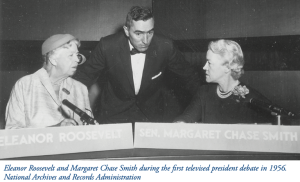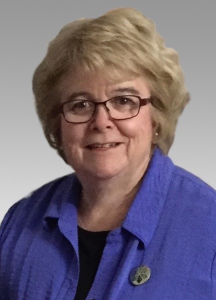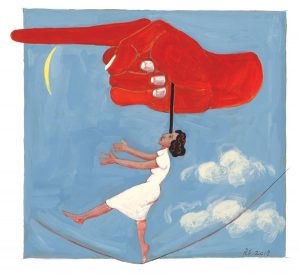A Life Committed to Leadership: Life Lessons from Margaret Chase Smith and Outcomes That Would Please Her
by Linda Cross Godfrey
July 13, 1964, might have been any other hot summer Saturday on a farm outside the small town of East Tawas, Michigan. A junior in high school, it was my turn to vacuum the family living room. Turning on the television for distraction, I came upon the opening ceremonies for the four-day National Convention of the Republican Party at the Cow Palace in Daly City, California. What unfolded over the next few days changed my life, inspired my heart, defined my career, and enticed us to become residents of Maine.
A group of eight men, each seeking the presidency of the United States, circulated in front of the news cameras, making pronouncements and promises and being interviewed — Nelson Rockefeller, Walter Judd, Henry Cabot Lodge Jr., Hiram Fong, Harold Stassen, William Scranton, Barry Goldwater, George Romney. Amid the furor, a milestone occurred: Senator Margaret Chase Smith of Maine became the first woman to receiver a presidential nomination by a major party. Even though the senator from Maine did not fare well in the delegate count, her attempt was credible, her message solid, her high moral character obvious. Unlike the male candidates, Senator Smith never conceded her place in the nomination process, which in the end kept Barry Goldwater from achieving 100 percent of the delegates.
This was the first day I saw, heard, and was inspired by Margaret Chase Smith. I later learned she had been the first woman to serve in both houses of Congress and the first woman federal political leader from Maine. As I researched further, I learned that Senator Smith had been the first national political leader to speak up and speak out against the scandal fueled by Senator Joseph McCarthy. I read Senator Smith’s “Declaration of Conscience” speech several times that summer, while other teens were focused on “Hard Day’s Night,” by the Beatles, “Rag Doll” by the Four Seasons, or “I Get Around” by the Beach Boys. It was clear in our family, with two parents involved in local politics and organizational leadership, that I had experienced an epiphany of sorts. I was now focused on women as leaders, public speaking, and the state of Maine. Those same areas of high interest born that summer of 1964 are still with me today— as personal passions, career choices, and public commitments—54 years later. Research revealed more about Senator Smith and introduced me to another woman political leader. From the archives of the US Senate, November 4, 1956:
Which presidential campaign produced the first nationally televised debate? The typical answer to that question is 1960, Kennedy v. Nixon. In fact, the first televised debate occurred four years earlier, when Democratic candidate Adlai Stevenson challenged incumbent Republican president Dwight Eisenhower—but those two men did not appear in the debate. Instead, on November 4, 1956, two surrogates debated the issues on network television. For the Democrats, former First Lady and party icon Eleanor Roosevelt. For the Republicans, the senior senator from Maine, Margaret Chase Smith. That’s right—the first televised presidential debate featured two women.1
Reading about Senator Smith’s preparation and presentation for this debate—from planning not just her words, but also her speech pattern, her attire, the size of the characteristic fresh red rose on her lapel, the decision to sit on two phone books to raise her to sit eye to eye with Mrs. Roosevelt— provided me with ideas and actions I used over the years and applied in campaigns I led for other candidates.

In 1968, as a junior at Central Michigan University (CMU), I was active in the nationwide Associated Women Students (AWS) organization. When the opportunity came to attend the annual convention at the University of Maine in Orono, eight other AWS student leaders from CMU and I arranged for our tickets and boarded the plane. In what would be very unlikely to happen today, about ten minutes from landing at the Bangor airport, the captain’s voice came over the loud-speaker: “We’re early today, and it’s such a lovely day, instead of flying all the way over land directly from Detroit to Bangor, we’re going to swing out over the ocean and fly up the coast of Maine.” After that glorious view of Maine’s coast- line, and after I had been elected to be a national vice president of AWS, we sold the Bangor-to-Boston portion of our flight home, rented a van, and drove down the coast of Maine. Together with the glorious views, I was in Margaret Chase Smith’s Maine; I was smitten.
Three years later, as a staff member of the Student Affairs Division at Indiana State University, I was asked to be the chairperson for the annual Women’s Week Program. Our committee invited four nationally known women leaders, hoping one would accept and be our major presenter: Helen Gahagan Douglas, US Representative from California, actress, and champion of migrant workers; Jeane Kirkpatrick, American diplomat, political scientist, and author (later to become US Ambassador to the United Nations); Gloria Steinem, cofounder of MS magazine, activist, and leader in the Equal Rights Amendment movement; and Margaret Chase Smith, by now one of the nation’s most admired women, an influential member of the Senate, and a strong woman leader willing to speak her conscience. While hoping one of these women leaders would accept our invitation, we were actually expecting four letters declining. Imagine our surprise when all four women accepted! We decided to seize this rare opportunity, raise more funds, set up hosting sites for each, and welcome them to what became the Women’s Week of our dreams, and the university’s pride.
I had selected Senator Smith as the guest I would arrange housing for, and placed her in the home of a mentor and Indiana political leader, Elizabeth Foster Blumberg, who lived near the university.There, Senator Smith not only had a great room and delicious food, but on her last day, we took her into the nearby woods for a rare experience of picking pawpaws. The magic of the experience was not lost on Senator Smith, and the friendship she and I started at that time lasted through many years and includes correspondence that is archived at the Margaret Chase Smith Library.
The following selections from letters we exchanged speak to the value of an admired elder leader supporting a younger follower and stand as an example of inspiring and supportivewords that can help develop a new generation of community leadership. This exchange with Margaret Chase Smith over the years also honors her loyal assistant, Angie Stockwell, secretary to Senator Smith from 1983 to 1995 and current collection specialist at the library, who I always believed made it possible for the senator to be such a great letter writer.
October 28, 1988: It was a joy having you here even for a brief time….I hope you will be back from time to time until you come to stay. Many thanks for your kind words and friendship. [On every visit to the MCS Library, after a conversation, Senator Smith would take out a small step stool, raise herself to wind the grandfather clock in the corner of her living room, hand Bob her car keys, and we’d go to her favorite place for lunch. Lunch was always half of a grilled cheese sandwich, which the senator requested be slightly burned.]
May 10, 1989: Honorary degree from Indiana University! Truly it was one of the most perfect events I have attended in a long time. Of course, it was a very high honor coming to me and the day will be one of my most cherished memories through the years. [On receipt of an honorary degree from Indiana University, which my mentor Betty Blumberg, a member of the Board of Trustees, and I were please to achieve. This became Senator Smith’s ninetieth honorary degree.]
May 8, 1995: How pleased I am to hear from you and to know of your activities and all that goes on around you…your words touch me deeply, and I am most grateful to be remembered. [Senator Margaret Chase Smith died at her home and library 11 days later. On a visit a few years earlier, she commented that all was readied, so when she died, the front door could be closed for five minutes and reopened to be her library and museum.]
Years of studying Margaret Chase Smith’s leadership style, visits with her, and our written correspondence have influenced me personally and professionally. I learned that we both are the eldest daughters in a sibling family of six, with that big-sister role a perfect training ground for developing early leadership skills. We also shared a preference for simple living and hard work, a thirst for learning, a respect for all people, and confidence in women to do anything and everything.
Receiving the senator’s personal words of encouragement, her mentoring, and what we today call “personal coaching” gave me an influential and admired voice to shape my thoughts, words, and actions. Thankfully, I have a lovely stack of letters, tied up with a white silk ribbon, that continue to inspire and guide me:
January 29, 1990: You are the ‘Number One’ idea woman I know…always so constructive….
March 15, 1990: I am so impressed with your enthusiasm and optimism….
September 17, 1990: Few have the courage and the feeling that someone must be leading the way, and this is what you are making every effort to do.
April 23, 1991: Keep up your courage and continue as you have, striving for that which you have wanted for so long.
Senator Smith’s calm and clear speaking voice, her welcoming inclusion, and a consistently high expectation of herself as a leader guide me daily.
During my last visit with Senator Smith I asked, “Who are the political leaders you believe are most like you?” There was barely a breath between question and answer, “Senator George Mitchell and Senator Olympia Snowe,” she said in an absolute tone. I followed up, asking what she saw in them? Another immediate answer: “Senator Mitchell is a man of great integrity and ethics. Senator Snowe studies the issues, shows up, stands up and speaks up.” Then, with a little smile, she added, “And, they both love Maine and Maine people.” I have made her response a great summary, which I aspire to daily in my own leadership work.
Inspired by Margaret Chase Smith’s leadership example, I have founded the Atlantic Leadership Center (http://www.atlanticleadershipcenter.com/index.html) in Eastport, Maine. The center’s newest initiative is the Three-Nation Leadership Initiative. The intent of the program is to expanded leadership work by bringing together talented, and younger, thinkers and leaders from Washington County, Maine, three nearby tribal communities, and Charlotte County, including the Fundy Isles, of New Brunswick. Starting in April 2018, the program is offering six classes in six communities: Calais, Trescott, Eastport, and Milbridge, Maine; and St. Stephen and Campobello Island, New Brunswick. The classes cover six different aspects of leadership: Nikanke/Leader, Storyfinder/Leader, Place Maker/Leader, Cultural Champion/Leader, International Citizen/Leader, and Deliverer/Leader.
Our Save Passamaquoddy Bay 3 Nation Alliance was awarded the Maine Chapter of the Sierra Club’s Local Grassroots Leadership Group Award, for preventing the development of three liquefied natural gas terminals in Passamaquoddy Bay. This was a 12-year battle against a number of the country’s largest legal and consulting firms, deep-pocketed investors who put $90 million into the effort, and against all odds. Our work was based on proven leadership patterns and practices and guided by the example of Margaret Chase Smith to stand up, and speak out, and do what’s right.
Now, for a great announcement about the outcomes of a five-year national project to find examples of cities and towns showing positive community development, local leadership, and culminating in a new book, Our Towns: A 100,000 Mile Journey into the Heart of America. This book will turn the spotlight on Eastport (and 28 other selected communities) and our collective work to revive and advance our community. The American Futures Project, a partnership of The Atlantic, National Public Radio, and Esri, launched this nationwide exploration in 2013 to find the best example of a resilient and reinventive city or town in each state. Through personal visits and interviews, the journalistic team of James and Debra Fallows and Kai Rysdall have collected stories of the selected locations over the past five years and now will take their work into the world, with the publication of the book this spring.2
Here is a sampling of what the journalists and producers leading the American Futures Project have said about Eastport. Senator Smith would be pleased about this, and so are we.
Since our first visit in the fall of 2013, Deb and I have reported frequently on the grit, vision, resilience and apparently indomitable drive of the roughly 1300 people who live in the little city of Eastport, Maine. (Fallows 2017)
Here is why I’m writing about Ajo—and Xizhou, and Eastport, and even Yellow Sheep River—late at night.…to emphasize the emotional power of seeing social capital being created, as we now realize we have done in all of these different-but-similar places.
Everyone knows about financial capital-creation, and we assume it is carried out on Wall Street or Sand Hill Road or by gnomes in Zurich. Social capital is as precious and necessary as financial capital.…And it has been surprisingly moving to get to know people who are investing themselves in the lives of their communities, even if conventional economic or career- strategy analysis might suggest that this is a waste of time. (Fallows 2015)
Yes, Margaret Chase Smith would be pleased with Eastport and the leadership efforts her life definitely inspired, and I believe she’d send a letter saying
so.
Endnotes
1 https://www.senate.gov/artandhistory/history/minute/The_First_Televised_Presidential_Debate.htm
2 For more information about the project, visit the website https://www.theatlantic.com/projects/city-makers-american
-futures/
References
Fallows, James. 2015. “From Xizhou to Eastport to Ajo: Big Dreams in Small Towns.” The Atlantic (April). https://www.theatlantic.com/national/archive/2015/04/from-xizhou-to-eastport-to-ajo-big-dreams-in-small-towns/390105/
Fallows, James. 2017. “A Big Step for Little Eastport.” The American Futures Notebook. https://www.theatlantic.com/notes/2017/01/a-big-step-for-little-eastport/513242/

Linda Cross Godfrey is president of the Atlantic Leadership Center in Eastport, Maine, and a partner in The Commons, Inc., and Dirigamus, LLC, also in Eastport. She is an educator, entrepreneur, community leader, and author and has been described as “one of Maine’s most inspiring speakers.” Godfrey lives by words from her leadership inspiration, Margaret Chase Smith: “And this I do believe above all, especially in times of greater discouragement, that I must BELIEVE—that I must believe in my fellow people—that I must believe in myself—that I must believe in God—if life is to have any meaning.”

